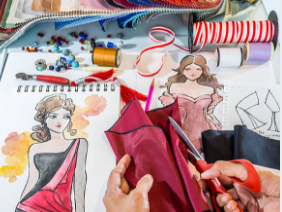

Fashion design is a style of art that focuses on the development of clothes and other accessories that are a part of a person’s daily routine. Ready-to-wear and haute couture are the two broad divisions of contemporary fashion design.
There are two types of confection collections: creator/designer and confection collections. Designer collections are often of higher quality, with a smoother finish and a distinctive design. They are often embodiments of a certain ideology, and they are usually made to make a point rather than to be sold. As international catwalks take place, both haute-couture and ready-to-wear collections are showcased.
What would fashion be like in, say, ten years? What would it be like in the twenty-first century? Since the end of my first year of university, I’ve been reading and researching various fields. A LOT, in fact, one of my favourite things to do is conduct research, and writing about fashion is just a small part of a larger, let’s call it, “hobby” that I can’t seem to stop doing during the academic year (but which I hope I can focus once I finish the Architecture degree). When it comes to reading, I’ve been engrossed in a book written by professor Alberto Campo Baeza called “I Want to Be an Architect” for the past week. He explains why we should be serious about design and why it is necessary to continue working with correction and rigour in whatever area we want to participate in this book (which is super light and enjoyable to read).
I’ve always tried to apply the same discipline and habits I use in architecture to everything related to blogging, particularly fashion blogging. This requires a lot of forethought on what is yet to come in the world of fashion. If anything, I believe three main elements characterise the matter, and that would fail if any one of them is missing: products, workflow, and the final stage and receiver in the case of fashion retail: the customer.
To begin, there is a great deal to tell about potential fashion fabrics. Synthetic, eco-fibres and recycled fabrics will pave the way for innovative approaches to fashion design that do not harm the environment. When we no longer use the item in our closet, it can be made in a manner that is similar to zero waste, and the source products used will be so technologically sophisticated that they will either maximise the amount of oxygen present in the air or transform into some sort of plant.
The upcoming apparel modelling workflow will be aided by technology that will enhance and accelerate all production processes. We would be able to print our own custom and high-tech fabrics at home using 3-D printing. Design is about more than just the artistic process; it’s all about improving culture and the economy. Designing for the future, hopefully, would result in a more equitable, egalitarian, and productive supply chain. That would also imply that fashion designers consider the first buyer of a completed fashion garment and the many lives that a piece of clothing will have by reusing and recycling. Even in the early stages of production, fashion would be more participatory and personalised. If it is already possible to make almost any concept into practice simply by sketching it, it will go much further in the future.
Last but not least, designing for the future can almost entirely be done by and by people. Create for a future that has yet to be created. To seek out the most efficient means of achieving objectives while maximising the use of usable materials and services. Designing for the future is an open portal to a world of possibilities.
If you want to be successful in fashion designing, education or correct training in it should be your primary goal. JD Institute Of Fashion Technology, which reflects a legacy of over 32 years and is one of the oldest premium institutes in the field of art and creativity, provides you just that with its various types of fashion designing courses and other courses. All of which are industry-based so that the students can get a hold of the real world and become ready for it accordingly, for example, through seminars from the industry leaders, international exchange programs, etc. JD Institute shares a vision of providing the best infrastructure, resource library etc. so that no external factor becomes a barrier in the journey of their students.
Due to their out-of-the-box teaching methods or contribution to the field of education and record-breaking placement of 99% with their students working for top organizations and making a name for themselves in their respective industries. JD Institute has been awarded various tokens of recognition such as the international glory award, the times’ power icon award, leaders in education award, etc., and your brighter future is waiting for you. Enroll now!